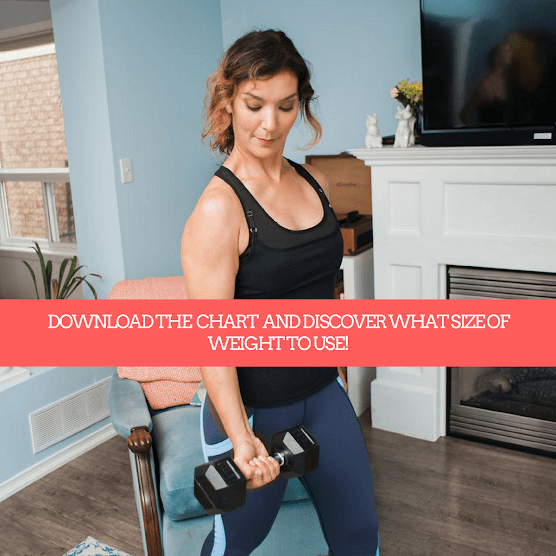What size of weights should I use to feel firmer and stronger after 50? How do I know if my weights are heavy enough? Am I pushing myself too hard? Will I feel sore and achy for days and feel like I’ve done more damage than good? Or maybe I’ve not done enough?
How do I know exactly how much weight I’m supposed to lift to enhance my strength, (which includes increasing my bone density) and firm up my body without going overboard or doing too little?
This is a common question I get asked by my clients after 50, and there’s a really simple solution! Take this simple test to find out for sure. It’s 3 simple steps and it never fails.
This test really takes into consideration that you are unique. The amount of weight you may be able to lift will differ depending on your own personal strength, your level of fitness and your genes. The only way to know for sure is to test yourself and discover the answer.
You’ll discover the exact size of weight that will grow your lean muscle (but I promise it won’t bulk you up) and give you a firmer and stronger physique. So, are you ready to find out your results. Let’s get started!
Step 1: Figure out your repetitions range: This is based on your goal
If you’ve done fitness classes, or gone for long walks holding light weights or using ankle or wrist weights to make your workout more beneficial, while doing really high repetitions (repetitions that exceed 15 -20) this may not get you those stronger firmer muscles you’re aiming for.
Increased bone density, (and enhanced lean muscle) only happen when the body senses you’re putting it under a greater demand than usual. The bones and muscles repair to become stronger and firmer to prepare for the next heavy demand you’ll put your body through. This is known as Wolf’s Law.
If you can continue to lift weights for an entire exercise class, or for your long walk, you’re not pushing yourself hard enough to elicit greater demand, so it won’t give you stronger or leaner muscles. You may even feel frustrated that you’re trying so hard to firm up without any real results. So ditch the high rep range!
If you’re just starting out after a long time off, or you’ve never really done a resistance program in the past, then start with 15 repetitions.
If you’ve already been exercising a while and you’re ready for a harder workout to create more strength, to increase your bone density, and create more lean muscle aim for 8-12 repetitions (begin by aiming for 12 and then work your way down).
Don’t feel afraid to exercise with heavier weights and lower repetitions. It won’t bulk you up or make you look manly. In fact, lifting heavier can burn more fat by enhancing lean muscle in charge of calorie burn, it will make you stronger and stave off osteoporosis. It’s a win all around!
Step 2: Pick a Weight That Feels “Doable” and Try to Get to Your Magic Number: Did you make it?
So now you’ve decided to start at 15 repetitions, or you’re aiming for 8-12. The next step is to lift the weight and see how you do.
Each muscle will feel different. for example, your upper back is made up of a powerful group of muscles so you may be able to use heavier weights for your upper back workouts, while your biceps are made up of smaller amounts of muscle and you may need to use much lighter weights.
The Last 3 Repetitions Tell All: The last 3 repetitions should feel harder. You want to feel the fatigue of your muscles.
If you struggle to reach your magic number the weight is too heavy and you need a lighter size.
If you surpass the magic number of repetitions , the weight is too light and you need a heavier weight.
Mark down your weight and the amount of repetitions you were able to complete to find out how much more (or less) weight you can lift.
Step 3: Discover Your Exact Size of Weights to Feel Firmer and Stronger After 50
It’s time to discover exactly how much more (or less weight you’ll need to lift). To do this you’ll need a simple chart that’s been tested as an accurate, science backed measurement tool that us Kinesiology Coaches use as a prime assessment tool.
Download the Chart Below

Once you’ve downloaded the chart, you’ll match the number of repetitions you were able to complete (the top row on chart ) and the repetitions you wanted to do (left column). Wherever those two numbers meet, that’s the amount of weight you’ll need to increase or decrease next time.
Notice how some columns don’t have any plus (+) or minus (-) weights numbers? That’s because you’ve already found the perfect weight and there’s no need to increase or decrease the weight.
So, are you ready to find out what size of weights to use to become firmer and stronger after 50!? Download the chart to get your results:
